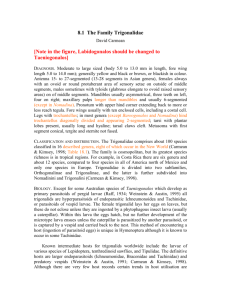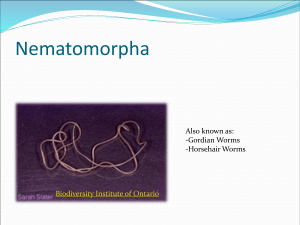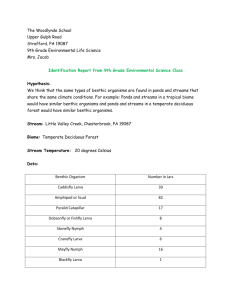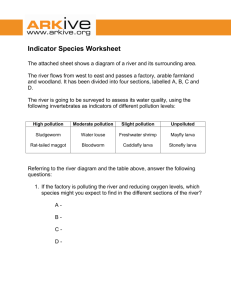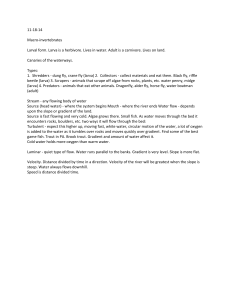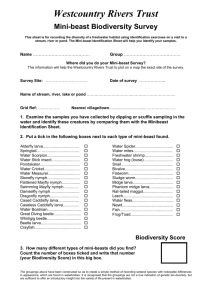TRIGONALIDAE
advertisement
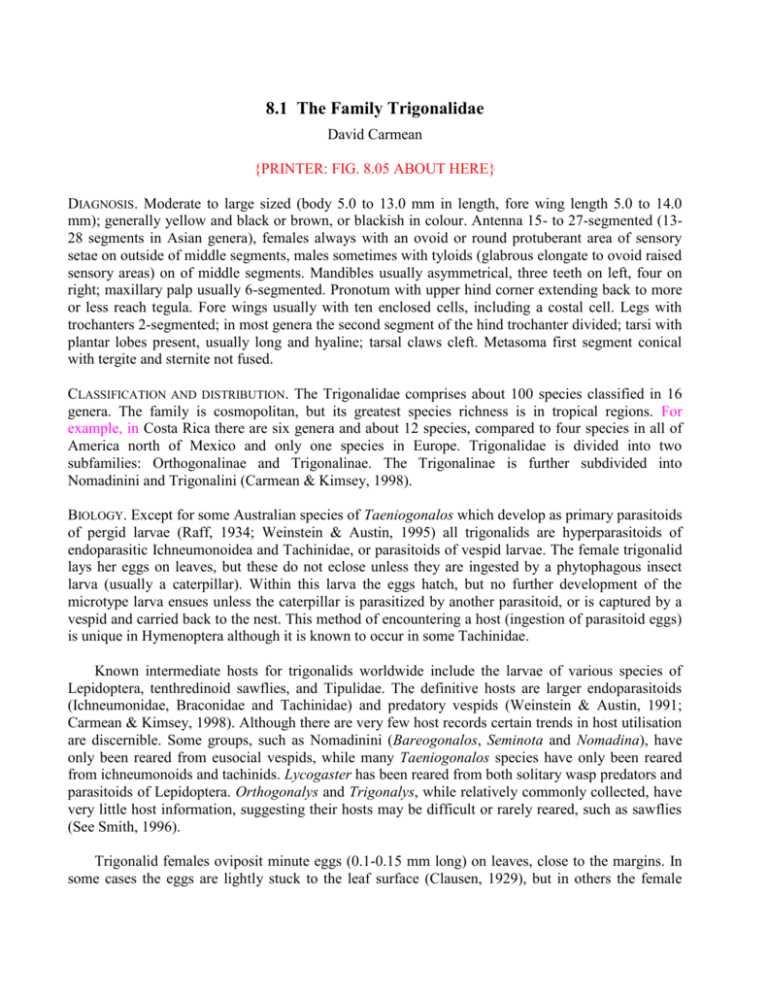
8.1 The Family Trigonalidae
David Carmean
{PRINTER: FIG. 8.05 ABOUT HERE}
DIAGNOSIS. Moderate to large sized (body 5.0 to 13.0 mm in length, fore wing length 5.0 to 14.0
mm); generally yellow and black or brown, or blackish in colour. Antenna 15- to 27-segmented (1328 segments in Asian genera), females always with an ovoid or round protuberant area of sensory
setae on outside of middle segments, males sometimes with tyloids (glabrous elongate to ovoid raised
sensory areas) on of middle segments. Mandibles usually asymmetrical, three teeth on left, four on
right; maxillary palp usually 6-segmented. Pronotum with upper hind corner extending back to more
or less reach tegula. Fore wings usually with ten enclosed cells, including a costal cell. Legs with
trochanters 2-segmented; in most genera the second segment of the hind trochanter divided; tarsi with
plantar lobes present, usually long and hyaline; tarsal claws cleft. Metasoma first segment conical
with tergite and sternite not fused.
CLASSIFICATION AND DISTRIBUTION. The Trigonalidae comprises about 100 species classified in 16
genera. The family is cosmopolitan, but its greatest species richness is in tropical regions. For
example, in Costa Rica there are six genera and about 12 species, compared to four species in all of
America north of Mexico and only one species in Europe. Trigonalidae is divided into two
subfamilies: Orthogonalinae and Trigonalinae. The Trigonalinae is further subdivided into
Nomadinini and Trigonalini (Carmean & Kimsey, 1998).
BIOLOGY. Except for some Australian species of Taeniogonalos which develop as primary parasitoids
of pergid larvae (Raff, 1934; Weinstein & Austin, 1995) all trigonalids are hyperparasitoids of
endoparasitic Ichneumonoidea and Tachinidae, or parasitoids of vespid larvae. The female trigonalid
lays her eggs on leaves, but these do not eclose unless they are ingested by a phytophagous insect
larva (usually a caterpillar). Within this larva the eggs hatch, but no further development of the
microtype larva ensues unless the caterpillar is parasitized by another parasitoid, or is captured by a
vespid and carried back to the nest. This method of encountering a host (ingestion of parasitoid eggs)
is unique in Hymenoptera although it is known to occur in some Tachinidae.
Known intermediate hosts for trigonalids worldwide include the larvae of various species of
Lepidoptera, tenthredinoid sawflies, and Tipulidae. The definitive hosts are larger endoparasitoids
(Ichneumonidae, Braconidae and Tachinidae) and predatory vespids (Weinstein & Austin, 1991;
Carmean & Kimsey, 1998). Although there are very few host records certain trends in host utilisation
are discernible. Some groups, such as Nomadinini (Bareogonalos, Seminota and Nomadina), have
only been reared from eusocial vespids, while many Taeniogonalos species have only been reared
from ichneumonoids and tachinids. Lycogaster has been reared from both solitary wasp predators and
parasitoids of Lepidoptera. Orthogonalys and Trigonalys, while relatively commonly collected, have
very little host information, suggesting their hosts may be difficult or rarely reared, such as sawflies
(See Smith, 1996).
Trigonalid females oviposit minute eggs (0.1-0.15 mm long) on leaves, close to the margins. In
some cases the eggs are lightly stuck to the leaf surface (Clausen, 1929), but in others the female
holds the leaf in a notch formed between a projection from the second or third sternite and the last
sternite, and punches the epidermis and inserts an egg into the mesophyll (Rodd, 1951a; Carmean,
1991). Some trigonalids appear to be unselective in their oviposition sites and one Costa Rican
species has been reared from intermediate hosts feeding on plant species in eight families. D.H.
Janzen (pers. comm.) has reared Taeniogonalos gundlachii in Costa Rica from both tachinid and
ichneumonid parasitoids of various large Lepidoptera found on eight plant families. In North
America Lycogaster pullata has been recorded as ovipositing on plants from such diverse families as
Fagaceae, Rhamnaceae and Asteraceae (Townes, 1956). This variety indicates that most trigonalids
are not specific for oviposition, intermediate, or definitive host. However, Bareogonalos canadensis
oviposited faster (once every 2.2 seconds) and for longer periods on Douglas Fir, compared to
oviposition on other foliage, which was too erratic to measure (Carmean, 1991).
Trigonalids are extremely fecund and capable of laying several thousand eggs in their short adult
life (Clausen 1929, 1931; Carmean, 1991). These eggs apparently do not develop further unless
ingested by a folivorous insect larva. When in the gut of a folivorous insect the eggs hatch and it is
assumed that the microtype trigonalid larvae penetrate the gut wall and enter the haemocoel. In all
New World trigonalids there is no further development unless the folivore is preyed upon or
parasitized by a suitable definitive host. In these cases further development occurs in one of two
ways, either within the body of a primary parasitoid larva feeding within the host, or else within the
body of a vespid larva that has consumed the folivore. Once in this definitive host the trigonalid
undergoes five larval instars (including the first). The first three instars feed endophagously, but the
fourth emerges from its host and feeds ectophagously (Cooper, 1954; Yamane, 1973).
The first instar larva is minute (ca 0.1 mm long) with slender mandibles and posteriorly directed
hooks and ventral spines (Clausen, 1931). The second instar larva lacks such hooks and has an
unchitinized head, while the third instar larva possesses a large chitinized head and large mandibles,
and is apparently adapted for eliminating supernumeraries (Yamane, 1973). The fourth instar larva is
more hymenopteriform while the final instar larva is robust, with distinctive tridentate mandibles
(Yamane & Kojima, 1982; Yamane & Terayama, 1983). At completion of feeding various species
have been observed to construct an irregular cocoon, a silken partition or no cocoon at all (Clausen,
1929; Yamane, 1973; Carmean et al., 1981; Yamane & Kojima, 1982). The size of the adult is
dependent on the size of the host it fed on (Carmean et al., 1981).
Key to Genera of Trigonalidae occurring in Tropical America
1
–
Tyloids not present, or female. Antennae filiform or thickened. .............................. 2
Tyloids present. Antennae filiform (males only)............................................................ 8
2
–
Maxillary and labial palpi rudimentary; antenna with 14 flagellar segments...... Nomadina
Maxillary palpus extends beyond mandibles, labial palpus normal; antenna with 15-26 flagellar
segments ............................................................................................................................ 3
3
Antenna with 15-18 (rarely 19) flagellar segments; metasoma smooth, shiny; mesosoma strongly
rugose punctate; hind trochanter two-segmented. ........................................ Bareogonalos
–
Antenna with 19-26 flagellar segments; if metasoma smooth and shiny, then mesosoma not
strongly punctate; hind trochanter apparently 3-segmented (second segment diagonally
divided). ............................................................................................................................. 4
4 Metasomal tergites and sternites very smooth and thin (may be partially transparent), tergites
folded under, intercalating with sternites; propodeum areolate-rugose, covered with network of
lines; carina around propodeal foramen thick, partially double-walled, "U" or half circle
shaped.
[Ichneumonid mimics; antenna banded, when viewed dorsally head and thorax black with
markings white (females and faded males) or yellowish white (males); metasoma reddish
brown, may have extensive light or dark markings.] ................................... Orthogonalys
– Metasomal tergites and sternites often punctate, thick, tergites overlap sternites laterally in a
straight line, without overlapping sternites ventrally; propodeum punctate, or smooth,
sometimes with concentric lines around foramen, but not covered with network of lines; carina
around propodeal foramen thin (though sometimes tall), and "V" or "U" shaped.
[Coloration various, not as above.] ..................................................................................... 5
5
–
6
–
7
–
8
-
Eye with sparse pubescence visible on clean specimens at 30 X.
Eye viewed from
below with hind margin behind mandible; propleuron and mesopleuron yellow and entire fore
wing amber; in some species vertex behind ocelli flat, at back abruptly angled towards occipital
carina; propodeal foramen evenly curved dorsally.
[Very rare.]...................................................................................................Xanthogonalos
Eye not pubescent. Eye with hind margin even with middle of mandible (less commonly at
hind edge of mandible; propleuron dark, mesopleuron dark or dark with yellow markings
(except some Trigonalys and Taeniogonalos ornata, which also have only the leading half of
the fore wing amber). ........................................................................................................ 6
Antenna spindle-shaped; propodeum without yellow or light markings; frons between antennae
broad and flat, wider than length of first flagellar segment; tyloids absent ...................... 7
Antenna filiform; propodeum often yellow marked; frons between antennae usually narrower and
not as flat as described above; tyloids present in male. ..................................................... 8
Wings amber or hyaline, not very dark; vertex curving evenly towards occipital carina.
[Parasitoids of solitary wasps or Lepidoptera] ................................................... Lycogaster
Wings, or part of wings, very dark or violaceous; vertex sharply angled above occipital carina.
[Parasitoids of social wasps.] ................................................................................ Seminota
Genal carina not forming a sharp ridge between gena and occiput, occiput not sharply excavated.
Frons flat or slightly angled between antennae in side view. Punctate above clypeus. Gena
usually narrow, often punctate, immediately above mandible and behind lower third of eye.
Female armature, if present, on sternum II. Male tyloids elongate, usually more than half
flagellomere length .................................................................................... Taeniogonalos
Genal carina forming a sharp ridge between gena and occiput when viewed from below; occiput
usually sharply excavated all the way to mandible. Frons strongly angled between antennae in
side view. Glossy above clypeus between antennae. Gena wide and shining immediately above
9
-
mandible and behind lower third of eye. Female armature, if present, on sternum III. Male
tyloids oval or round, less than half the flagellomere length ........................................... 9
Genal carina pointing towards hypostomal carina and then bending parallel to hypostomal carina
to reach mandibular base. Occiput not sharply excavated near mandible. Mexico, known only
from females ....................................................................................... Undescribed Genus
Genal carina extending straight to mandibular base. Occiput sharply excavated along genal
carina all the way to mandible. Central and South America ............................ Trigonalys
SYNOPSIS OF THE NEOTROPICAL
Kimsey, 1998).
FAUNA.
Eight genera are described in the New World (Carmean &
Bareogonalos. In tropical america Bareogonalos is known from only a few specimens representing
one species from the Guerrero State, Mexico. Four other species are known, all from the Pacific
region including Indonesia, Japan, Taiwan, Siberia, south-western Canada and north-western United
States. All are stout bodied and attack vespines.
Lycogaster. Two species occur in Central America, one ranges northwards to Canada. Four additional
species occur in south-east Asia. Species of Lycogaster mimic Brachygastra spp. (Vespidae).
Nomadina. The four species in this genus are limited to the Neotropical region, from Chile north to
Costa Rica. Related genera are found in the Philippines and Taiwan. Species have been reared from
Agelaia and Polybia (Vespidae).
Orthogonalys. This widespread genus (11 spp. total) is represented by one species in both North
America and a second closely related species in South America., but is apparently absent from most
of Central America.
Seminota. This genus is only known from 5 or 6 species, all from Central and South America.
Seminota mimics one of its host wasps, Parachartergus apicalis, and most collections have been
made by rearing individuals from vespid nests.
Taeniogonalos. The New World Taeniogonalos are represented by 7 neotropical species, with about
30 additional species known from the paleotropics. One species, apparently the same as the only
North American species, T. gundlachii, mimics Polybia occidentalis (Vespidae).
Trigonalys. A genus with 5 species known to extend from Brazil north into Central America.
Another 5 species are known from Africa and Asia.
Xanthogonalos. This neotropical genus is known from about three species and only a few specimens.
Additional references:
Carmean, D. & L.S. Kimsey. 1998. Phylogenetic revision of the parasitoid wasp family
Trigonalidae (Hymenoptera). Systematic Entomology, 23: 35-76.
Smith, D.R. 1996. Trigonalyidae (Hymenoptera) in the eastern United States: seasonal flight
activity, distributions, hosts. . Proceedings of the Entomological Society of Washington, 98: 109118.
Weinstein, P. & A.D. Austin. 1995. Primary parasitism, development and adult biology in the
wasp Taeniogonalos venatoria Riek (Hymenoptera: Trigonalyidae). Australian Journal of
Zoology, 43: 541-555.
Note in the figure, Labidogonalos should be changed to Taeniogonalos
